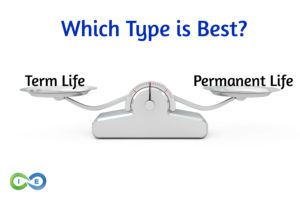The life insurance application process has become more user-friendly over the years, particularly with the advent of automated accelerated underwriting providing life insurance without an exam.
However, there are some key things you should know to ensure that the insurance underwriting process goes as smooth as possible.
You see, even if you qualify for accelerated underwriting from the best life insurance companies in the USA, there is still an application to fill out, with lots of questions to answer.
And often it may make sense to submit to life insurance blood testing to try and get the best whole life insurance rates possible.
So, let’s get into it…
Life Insurance Underwriting Process Snapshot
At the start you want to do you due diligence and research the companies and policies that fit your needs, goals and objectives.
If you are not sure what insurance company and policy is best for you, please give us a call and we will help you narrow your focus to the companies that bit fit your specific criteria or stop by our life insurance quotes page today.
Now from there, the next steps in the underwriting process are:
- Choose a company and policy
- Fill out the application
- Possible phone interview
- Schedule Paramedical Exam (if required)
- Take Paramedical Exam, including blood test and urine sample
- Specimens sent to lab work company
- Results sent to life insurance underwriter
- Rx database, MIB & MVR check
- Underwriter reviews results
- Health rate class assigned
- Policy approved
- Deliver requirements/Make payment
- Policy in force
Life Insurance Underwriting Process
What to Expect
You have finally decided that it is time purchase a life insurance policy. Maybe you were just married, had a baby, or it is an SBA loan requirement. Or maybe you stumbled onto the infinite banking concept. Whatever the case may be, you are finding yourself in need of life insurance.
Life insurance is very different from applying for homeowners insurance or car insurance, the primary reason, you have to talk about yourself. Whereas applying for home and auto insurance, you give out some personal information like your date of birth and social security number but all the application questions are about your home or vehicle.
The questions on a life insurance company application are designed to determine if you are a wise investment for the insurance company. So it gets pretty personal, pretty quick.
As well it should be because it is your life they are insuring.
However the crazy thing is as humans, we seem to want to flub a little bit about specific details of our lives. It could be something as simple as our fudging our weight or to lying about the medications we take.
But insurance company underwriters are wise to this, and they know or will find out more than you think they will.
Life Insurance Application, The Good, The Bad and The Results
The life insurance company, the product you choose, and the amount coverage you choose are going to determine how involved the application process is. There are various types of policies out there, and each has a set of underwriting guidelines to abide by.
The following different types of life insurance exist:
- Fully Underwritten
- Accelerated Underwriting
- Simplified Issue
- Guaranteed Issue
Both fully underwritten and accelerated underwriting products may require a background check, including a look at your motor vehicle record (MVR), medical information bureau (MIB), credit history, and any additional information provided by Big Data.
Simplified issue life insurance requires an application. There are different simplified issue policies. Some require a background check as well, while other policies do not. Further, some applications have only a few questions, while other applications may be more thorough.
Guaranteed issue life insurance does not require answers to any health or lifestyle questions and there is no exam required. The only parameters are that the policy is available in your state and that you meet the age requirements. These policies are typically for ages 45-85.
Fully Underwritten vs Accelerated Underwriting
You will have to give the following personal information to begin the application process for most insurance policies requiring underwriting:
- Height
- Weight
- Date of birth
- Social Security Number
- Lifestyle habits (i.e., smoking, drinking, exercise)
- Financial information, this is your annual income and net worth
The Underwriter’s Bible aka The Underwriting Guidelines
Every insurance company has its own underwriting guidelines. The guidelines defines the parameters that an individual company will use to decide your final rates.
Most companies require a life insurance blood draw and paramedical exam, but more and more companies are moving to automated accelerated underwriting.
A specific life insurance company’s underwriting manual will declare things like which service a company underwriter should use for obtaining an Attending Physician Statement online, which situation requires a prescription history report, how height and weight relate to health classifications, and more.
This all means that since each company has their own underwriting guidelines, there are other variants in the process and protocols, such as which tests are ordered, what tools are used, and how all of this affects your final life insurance rates.
Some insurance companies that practice automated accelerated underwriting may only require answering health-related and lifestyle questions on the application. It may be tempting to skew the answers in your favor, but you should be truthful when providing your answers.
Others may require a paramedical examiner to perform an oral swab test which consists of a swab of the inside of your mouth and then off to the lab for results.
Most insurance companies though are going to require that you do an in-person medical exam or paramedical with a medical professional. Life insurance paramedical exams have come a long way, and these can usually be scheduled in your home, office or clinic at your convenience.
What to expect during your life insurance medical exam:
Take your medical history (including medical conditions, surgeries, and any prescription medications)
- Ask about your immediate family’s medical history
- Take your blood pressure
- Listen to your heartbeat
- Check your height and weight
- Draw a blood sample
- Obtain a urine sample
- Question you regarding lifestyle habits that could affect your health (e.g., exercise, smoking, drinking, recreational drug use, frequent travel, high-risk hobbies)
For more information and tips about the medical exam, please visit our article covering what life insurance exams test for.
Some age groups, policy types, and coverage amounts may require additional testing such as an EKG, a chest XRay, and a treadmill test.
These additional requirements vary by company, by age and by amount of coverage.
Here are a few examples.
Age 39, $1,000,000 life policy
- Application
- Paramed exam
- MVR
- MIB
- Rx Report
Age 47, $2,000,000 life policy
- Application
- Paramed exam
- MVR
- MIB
- Rx Report
- Resting EKG
Age 59, $3,000,000 life policy
- Application
- Paramed exam
- MVR
- MIB
- Rx Report
- Resting EKG
- Inspection report
- Financial questionnaire
So, now you know what to expect from the application process, here is what the insurance company does with the information provided to them.
Information Your Insurance Company Obtains
Remember when you signed your insurance application, and there were all those teeny tiny words that you did not read?
Well, part of that is giving the life insurance permission to obtain specific data about you.
Things like a credit report, driving records,a prescription database check and medical records.
That is right, your insurance company has access to medical records. However, there are things that you can keep private that don’t pertain to the insurance application process.
Like driving records stored in a central system that agents can access, medical records are stored in a database known as the Medical Information Bureau
or MIB. While it will not be Will Smith or Tommy Lee Jones looking at your information a life insurance underwriter will.
The insurance underwriter will be able to see medical visits, hospital stays and insurance payments or denials.
It is important to note that the MIB also notes any previous life insurance applications you have completed that were denied and will report the red flag to any future insurers.
A prescription database check is exactly what it sounds like: a look at all of the medication prescribed to you in the last five to ten years.
Now, this is the part that if you lied on the application about any preexisting conditions or medications, it could get ugly. If the company finds you lied about a health condition or lifestyle, it can raise your premium, cancel your policy or deny a beneficiary’s claim to the death benefit, particularly during the two year contestability period.
The 2 Year Contestability Period
If you die in the first two years, the insurance company may do some further background checks. If it is shown you lied or made a misrepresentation on your life insurance application, the company may be able to deny your beneficiary’s death benefit claim.
Moral of the story—Don’t lie.
Now you understand why medical records are essential, but credit reports and driving records?
Easy, if you have a lead foot and the speeding tickets are mounting up, an insurance underwriter will see you as high risk due to lifestyle. The same is true for a credit report that shows you to be in large amounts of debt; they may view you as a high suicide risk.
What About the Surprise Results?
Let’s say that you answered all questions truthfully, informed the company about any medications or preexisting conditions, but your blood work came back with some surprises that you were not aware of?
Depending on what those “surprises” are, it may be as simple as increasing your rate or obtaining more information from your doctor known as an Attending Physician Statement.
However, latent health issues may also be grounds for a postponed or declined result. With a postpone, you may be able to get the company to continue the process once whatever red flag has been resolved. With a decline, you may have to wait 6 months or more before trying again.
Attending Physician Statement
If some surprises arise from your paramedical exam, the life insurance underwriter may order an Attending Physician Statement, or APS, to answer some outstanding questions.
An APS is a review of your medical history from your doctor’s point of view, with basic health information on it. This may seem silly since you if you just completed a paramedical exam, but the APS can provide a clearer picture of your health for the underwriter.
Sometimes an APS request is a great opportunity if your physician has some positive remarks for the insurance company. Other times, the physician’s statements may prevent you from obtaining life insurance coverage. It really comes down to what is in your record.
Life Insurance Classifications, Where Do You Fit In?
To make things easier for the life insurance company, underwriters came up with a classification system. Life insurance companies classify their risks in categories know as rating classes.
Preferred Plus – Insurance underwriters consider you an ideal risk. To get preferred plus you need to be in great health, abstain from dangerous hobbies or occupations and have a clean driving record.
Preferred – To receive a preferred health class rating you will need to be a low risk, with good to great health, abstain from dangerous hobbies or jobs and have a good driving record, with only some minor traffic violations.
Standard – Insurance underwriters view you as average risk. Maybe a history of a few health issues but you do not have a terminal illness or a high-risk job or hobby. You will pay average premiums for similarly situated insured parties.
Substandard -Insurance companies consider you substandard, or table-rated, if you have a high-risk occupation or pre-existing medical condition. Some examples of high risk medical conditions would be diabetes, cancer, heart disease or stroke.
Uninsurable – If you have a terminal illness you will not likely find an insurer that will sell you a policy. Insurance underwriters consider you too high of a risk.
The good news is that while you cannot change your age or family medical history, (two significant factors in determining the rate), it is possible to help put you in a better rate class by making a few adjustments:
- Quit Smoking
- Lose Weight
- Reduce or Eliminate Alcohol Intake
- Improve Your Driving
The Final Decision
Well, you made it through the application and exam process, now what?
The life insurance company collected all of the information possible about you, and now you’re just hanging out wondering if you meet their standards. The waiting game is never fun, but the good news is must people who apply will qualify for coverage.The tricky part is how much your premiums will be after the underwriting dust has settled.
A skilled life insurance underwriter will take all the information collected and look at compared to the company’s underwriting guidelines. This side by side comparison permits the underwriter to place you in a group of people with similar risk characteristics to yours.
Granted not everyone is going to die at the same time from the same thing, but the majority of the group will have a relatively predictable life expectancy. And your life expectancy is the most important factor to the insurance company.
How Long Does the Underwriting Process Take?
For accelerated underwriting, some applications are approved in 24 hours. This is the exception, and not the rule. Most automated accelerated underwriting approvals take 2-7 days.
The entire application process for fully underwritten applications can usually take anywhere from 3-8 weeks depending on what information has to be collected and relying on outside sources.
For example, waiting on a doctor’s office for an APS may add extra time. After that, all you have to do is sign the policy to put it in force, and your family is protected.
Each life insurance company underwriting criteria may be different. Each will have a different tolerance for risk. Different companies will cater to different health conditions. In some instances it pays to choose a company that is more favorable to your particular pre-existing medical condition niche.
Conclusion
At I&E, we help our clients get the best policy, with the best company, at the best price. We do this through our intimate knowledge of the top companies available and by asking our clients the right questions.
So what are you waiting for? Give us a call today to see what we can do for you!





